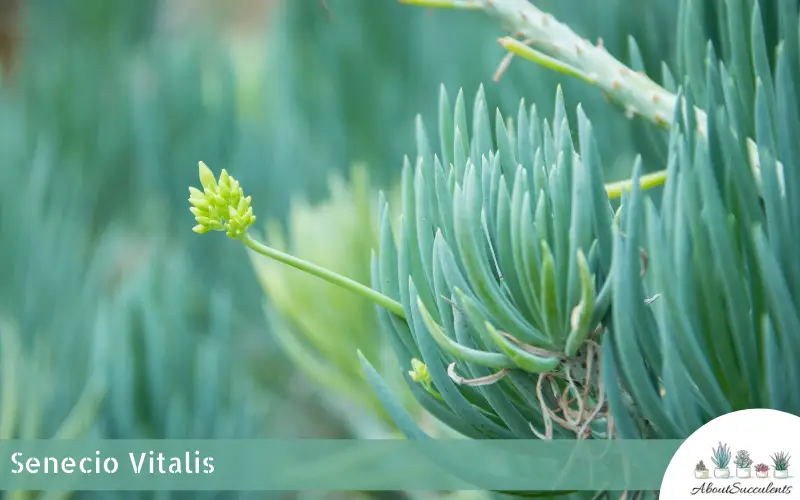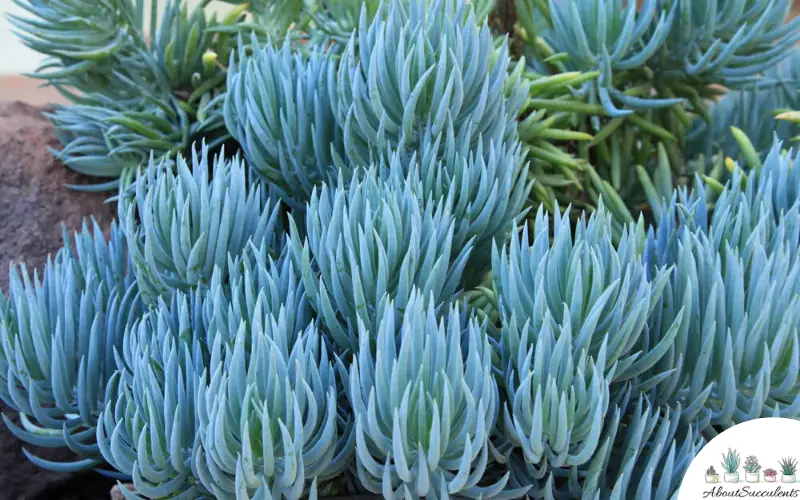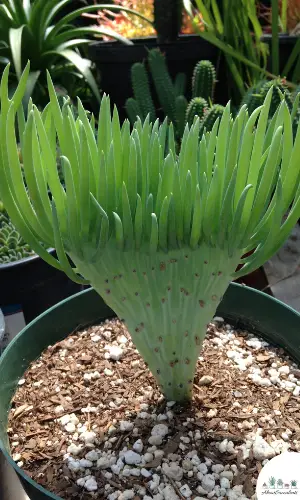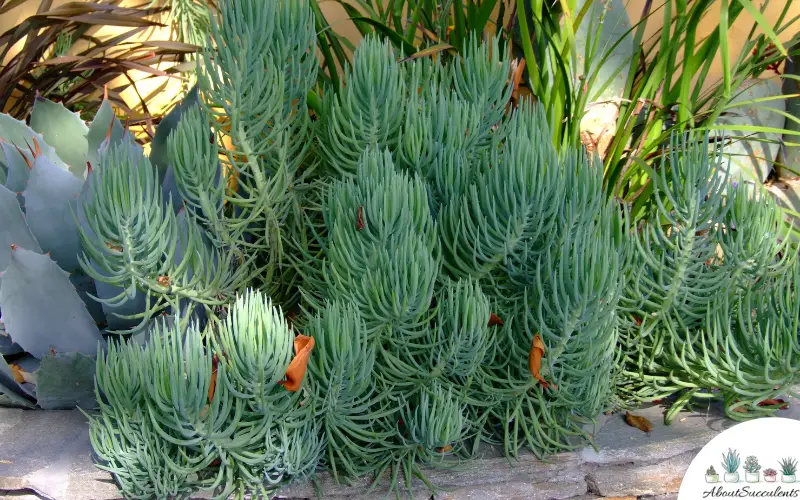
Senecio vitalis is a fast-spreading succulent that has great ornamental appeal which makes it the ideal plant for container gardens. Senecio vitalis is also called Blue Chalk Fingers and Narrow Leaf Chalk Sticks because of its elongated foliage which extends from the stem and gives it the appearance of having fingers.
Blue Chalk Fingers has greyish-green leaves that are 2.75-inches to 5.95-inches long (7cm to 15cm). Senecio vitalis has a waxy coating which protects it from hot and dry conditions. Once the coating of the leaf is removed or rubbed off, the succulent’s blue-green color will be revealed.
Senecio vitalis can grow up to 24-inches (61cm) tall and 60-inches (152.4cm) wide. The species originates from the Asteraceae family and is native to the Eastern Cape of South Africa.
General Information:
Also known as: Blue Chalk Fingers and Narrow Leaf Chalk Stick
Plant Family: Asteraceae
Origin: Eastern Cape of South Africa
Height: 24-inches (61cm))
Exposure: Full sunlight up to 6 hours; partial sunlight up to 4 hours
Water Needs: Frequent watering schedule during the summer months; very little to no watering in the winter or cold season.
Soil Type: Cactus soil mix will do or a regular potting mix combined with 1 part Pine Bark fines, 1 part Turface, and 1 part crushed granite
Soil pH: Acidic (6.0 to 7.0 pH)
How to Grow and Care for Senecio Vitalis

Senecio vitalis is an easy succulent to grow and take care of. The plant will be an excellent addition to a Mediterranean garden or a Rock garden. Blue Chalk Fingers propagates very fast and because it spreads quickly, be aware of where you will plant the succulent outdoors.
Keep in mind that Senecio vitalis can be toxic. Wear nitrile-dipped gloves when handling Blue Chalk Fingers.
Senecio vitalis is not a cold hardy succulent. If you live in a region where the temperatures can drop below 30° F (-1.1° C), it would be best to place the plant in a container that can be moved indoors.
1. Sunlight
If grown outdoors, place Senecio vitalis in an area in the garden that gets 6 hours of sunlight.
If Senecio vitalis is brought indoors, place the container near a window that gets partial to full sunlight.
2. Watering
Senecio vitalis is highly-resistant to drought and can survive long periods with water. The succulent is susceptible to root rot which is caused by overwatering. The best approach would be to water Blue Chalk Fingers only if the soil is dry to the touch and free of moisture.

3. Pot and Soil
It is important for Senecio vitalis to be grown in a pot that has good drainage. If the succulent stays in moistened soil for a long period of time, its roots will rot and spread disease throughout the plant.
The soil that you use to grow Senecio vitalis should also have good draining properties. A cactus soil mix will do or a regular potting mix combined with 1 part Pine Bark fines, 1 part Turface, and 1 part crushed granite.
Pine bark tends to hold water longer but has air pockets that allow proper ventilation. Turface which is an absorbent-type of rock takes in some of the water before slowly draining it out. The crushed granite helps clear out the excess water to keep the soil dry.
How to Propagate Senecio Vitalis
You won’t have a hard time propagating Senecio vitalis as the succulent is a prolific propagator.
Propagating Blue Chalk Fingers by using stem cuttings is the recommended method.
Step 1: Because Senecio vitalis can be toxic, put on a pair of nitrile-dipped gloves before proceeding to cut the stems.
Step 2: Use a sharp and sterilized knife or garden shears to cut the stem from near the base of the main plant.

Step 3: Place the stem cutting under a shaded area and allow it to dry and develop hard calluses. The process of developing calluses may take anywhere from 1 to 2 weeks.
Step 4: When the stem cutting has developed calluses, plant the cut part into the pot of well-draining soil.
Frequently Asked Questions
Is Senecio Vitalis Toxic for Cats and Dogs?
Senecio vitalis does not appear in the list of plants that could be toxic to cats and dogs on the website of the American Society for the Prevention of Cruelty to Animals (ASPCA).
There are reports that the succulent could be toxic to the touch. To be sure, handle the plant with gloves and keep away from pets.
Why is my Senecio Vitalis Succulent Dying?
Senecio vitalis is a resilient succulent that is only vulnerable to root rotting. The best way to preserve the health of Blue Chalk Fingers is to follow a tightly-controlled watering schedule.
Senecio vitalis can be watered frequently during the dry summer season. Give the plant water only when the soil is dry. In the wintertime, Blue Chalk Fingers will require significantly less water because the soil will stay moist longer.
Does Senecio Vitalis Produce Flowers?
Senecio vitalis produces 10 to 15 small, whitish cream-colored flowers that eise above the foliage during the early spring to late summer months.
Last Updated on June 10, 2022 by Sofia Lara